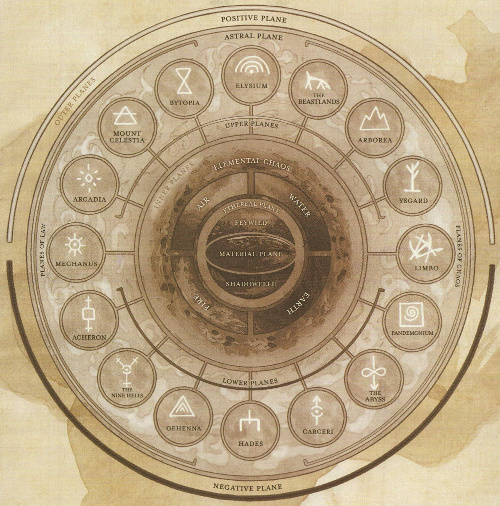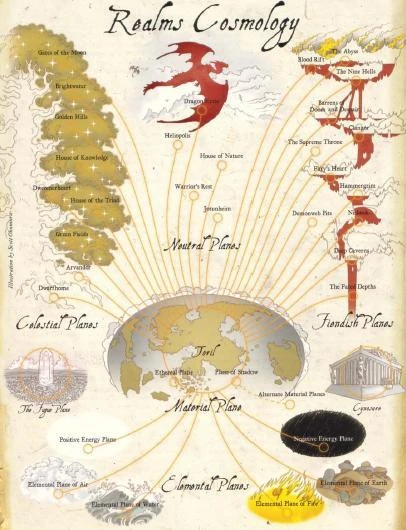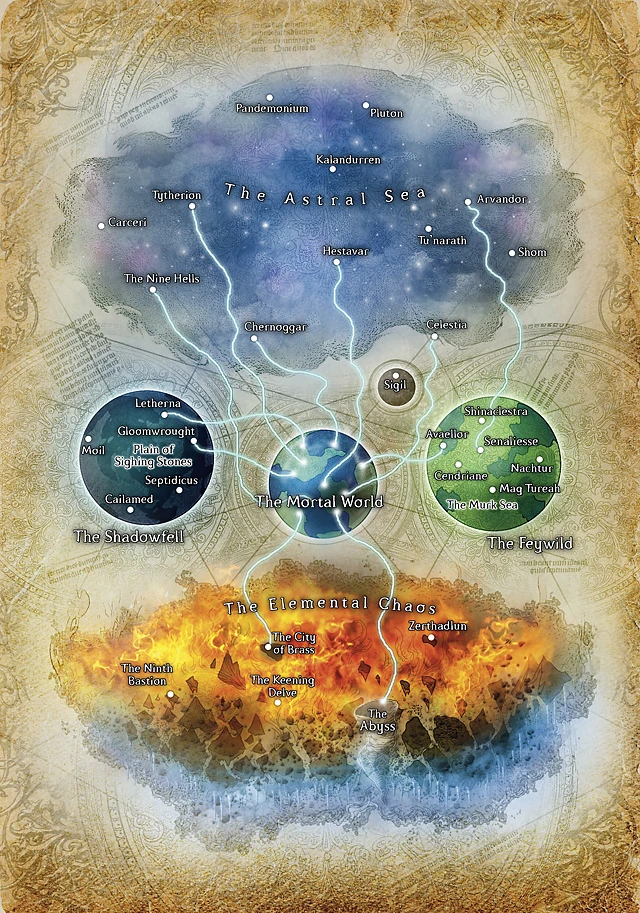The plane of Seven Heavens (also called the Seven Mountains of Goodness and Law or Mount Celestia[6]) was the pinnacle of lawful goodness in the Great Wheel cosmology.[1] The Seven Heavens were dedicated to goodness shaped by law and justice tempered with mercy. Some characteristics of this plane were ascribed to the World Tree cosmology planes of Green Fields[7] and the House of the Triad[8] when that cosmology became popular. Both Green Fields and House of the Triad (which became known as Celestia) survived the Spellplague[9] and became part of the World Axis cosmology.
Description
Each of the seven layers contained at least one mountain or high structure rising into the sky, and most had whole mountain ranges. The barriers between the seven layers were arranged such that entrances were at the lowest geographical points and exits were at the highest, so a traveler from the Astral Plane would enter the first layer at the base of a mountain (actually, in the surf of the ocean surrounding the mountain) and had to climb to the peak to reach the next layer, only to emerge at the nadir again. The sky of each layer had its own hue which softly bathed everything in gentle shades of luminance.[3]
Lunia
Known as the Silver Heaven, Lunia was the first layer travelers encountered. The sky of Lunia was a nighttime sky filled with stars that illuminated the layer with a silver glow.[3] The color pools of the Astral Plane would deposit visitors in the surf of a vast ocean,[3] the Silver Sea,[10] full of clean, fresh water that had the properties of holy water.[3] The dark, starry Silver Sea was full of many good aquatic beings, including celestial whales and sea elves.[10]
The adjacent beach belonged to an island with a majestic mountain decorated with grand citadels made from polished white stone. Descriptions of the citadels varied among travelers leading cosmologists to theorize that there were many of these mountain islands.[3] Also in the surf of Lunia were the portals to the Twin Paradises, Arcadia, and Concordant Opposition which were large, permanent, free-standing blocks of finished stone. Black granite blocks veined with gold led to Arcadia, white granite blocks with veins of silver led to the Twin Paradises, and red granite blocks flecked with blue took you to Concordant Opposition. Travelers merely had to touch a block to activate the portal.[2]
Mecuria
Mecuria was known as the Golden Heaven because a warm golden light suffused everywhere. This layer contained the armory for the noblest warriors who came here for their eternal rest. If necessary, Mecuria was the marshaling ground for the armies of the Heavens.[3] Bahamut's jeweled palace (perhaps one of many, or it was movable) was reported to be in this layer, among others.[2]
Venya
The third heaven, called the Heaven of Pearls, was a lush and verdant land with crops, meadows, moors, hills, and rolling countryside all bathed in the soft glow from a sky reminiscent of the luster of white pearls. The halfling pantheon once made its home in Venya and they called it the Green Fields.[3]
Solania
Solania had a sky that glowed like burnished silver and was called the Electrum Heaven. Its valleys were enveloped in mist and fog and its mountain peaks where often occupied by monastic buildings controlled by demigods. Many pilgrims came questing to the roof of this layer in the hopes of finding answers to life's persistent questions.[3]
Mertion
With a sky not too different from Solania's, the fifth layer was known as the Platinum Heaven. Vast plains and savannas served as the mustering ground for paladins and other lawful good servants. Instead of mountains, Mertion had majestic citadels and huge black spherical domes dotting the plains. Access to the next higher layer was found at the tops of the domes.[11]
Jovar
Jovar was known as the Glittering Heaven or the Heaven of Gems. This layer was actually a vault lined floor to ceiling with huge rubies and garnets that gave off a glow like a hearth fire. A seemingly unending ziggurat was the home of the Jovarian archons and guarded the entrance to the seventh heaven.[2]
Chronias
The seventh and last heaven was called the Illuminated Heaven and little is known of its structure because nothing has been recorded by the few who have visited and returned. The legends say that Chronias was so good and lawful that it glowed of its own accord and any who entered had all evil and neutrality burned out of them, leaving them inherently good, if they survived. Many religions made this level the home of their lawful good deities, believing any lesser realms were merely to accommodate less worthy souls.[2]
Inhabitants
The archons[12] were the native and most numerous inhabitants of the Seven Heavens, cheerfully going about the business of serving the Higher Powers. Many types of archons lived in the first six layers but only rumors existed of a ruling archon ensconced in Chronias. Other creatures found on this plane were solars,[13] planetars,[14] hollyphants,[15] devas,[16] foo creatures,[17] and agathia.[18] Human and non-human pilgrims, shedu, lammasu, ki-rin, and dragon horses[19] would visit fairly often.[2]
Afterlife
The spirits of those who earned a place in the Seven Heavens would become Lantern archons much the same as evil souls became larvae in the Lower Planes.[2]
Realms
- Arvoreen, the patron deity of halfling warriors, once made his home in Venya with the others of his pantheon.[20]
- Bahamut was reported to have realms in Lunia, Mecuria, Venya, and Solania as well as the Elemental Plane of Air. Whether these were separate realms or one realm that moved about, or possibly spanned several layers at once is still a matter of speculation.[2][21]
- Berronar Truesilver, Mother of Safety, Truth, and Home, lived with her husband Moradin in a mountain home in Solania.[2][22]
- Cyrrollalee, the halfling deity of friendship and trust, once lived in Venya with the others of her pantheon.[23]
- Moradin, the Soul Forger, chief deity of the dwarves, once made his home in Solania within the steep mountains which were called Erackinar in the dwarven tongue. It was here that Moradin kept the Soul Forge which he used to temper the spirits and weapons of his people. It was said the smoke from his forge became the mists filling the valleys and the heat from it warmed all of Solania.[2][24]
- Torm the True maintained his realm of Trueheart on the layer of Mercuria.[25]
- Tyr Grimjaws, the Even-Handed, once had a realm called the Court on the layer of Lunia.[26][27][28]
Appendix
References
- ↑ 1.0 1.1 1.2 Jeff Grubb (July 1987). Manual of the Planes 1st edition. (TSR), p. 73. ISBN 0880383992.
- ↑ 2.0 2.1 2.2 2.3 2.4 2.5 2.6 2.7 2.8 2.9 Jeff Grubb (July 1987). Manual of the Planes 1st edition. (TSR), p. 88. ISBN 0880383992.
- ↑ 3.0 3.1 3.2 3.3 3.4 3.5 3.6 3.7 3.8 3.9 Jeff Grubb (July 1987). Manual of the Planes 1st edition. (TSR), p. 87. ISBN 0880383992.
- ↑ Jeff Grubb (July 1987). Manual of the Planes 1st edition. (TSR), p. 75. ISBN 0880383992.
- ↑ Jeff Grubb (July 1987). Manual of the Planes 1st edition. (TSR), pp. 78–82. ISBN 0880383992.
- ↑ David "Zeb" Cook (1994). Planescape Campaign Setting. Edited by David Wise. (TSR, Inc). ISBN 978-1560768340.
- ↑ Richard Baker, James Wyatt (March 2004). Player's Guide to Faerûn. (Wizards of the Coast). ISBN 0-7869-3134-5.
- ↑ Richard Baker, James Wyatt (March 2004). Player's Guide to Faerûn. (Wizards of the Coast). ISBN 0-7869-3134-5.
- ↑ Bruce R. Cordell, Ed Greenwood, Chris Sims (August 2008). Forgotten Realms Campaign Guide. Edited by Jennifer Clarke Wilkes, et al. (Wizards of the Coast), pp. 62, 64. ISBN 978-0-7869-4924-3.
- ↑ 10.0 10.1 Richard Baker, Joseph D. Carriker, Jr., Jennifer Clarke Wilkes (August 2005). Stormwrack. (Wizards of the Coast), p. 10. ISBN 07-8692-873-5.
- ↑ Jeff Grubb (July 1987). Manual of the Planes 1st edition. (TSR), pp. 87–88. ISBN 0880383992.
- ↑ Jeff Grubb (July 1987). Manual of the Planes 1st edition. (TSR), p. 123. ISBN 0880383992.
- ↑ Gary Gygax (August 1983). Monster Manual II 1st edition. (TSR, Inc), p. 111. ISBN 0-88038-031-4.
- ↑ Gary Gygax (August 1983). Monster Manual II 1st edition. (TSR, Inc), p. 101. ISBN 0-88038-031-4.
- ↑ Gary Gygax (August 1983). Monster Manual II 1st edition. (TSR, Inc), p. 75. ISBN 0-88038-031-4.
- ↑ Gary Gygax (August 1983). Monster Manual II 1st edition. (TSR, Inc), p. 42. ISBN 0-88038-031-4.
- ↑ Gary Gygax (August 1983). Monster Manual II 1st edition. (TSR, Inc), p. 65. ISBN 0-88038-031-4.
- ↑ Gary Gygax (August 1983). Monster Manual II 1st edition. (TSR, Inc), p. 9. ISBN 0-88038-031-4.
- ↑ Gary Gygax (August 1983). Monster Manual II 1st edition. (TSR, Inc), p. 59. ISBN 0-88038-031-4.
- ↑ Gary Gygax (August, 1985). Unearthed Arcana (1st edition). (TSR, Inc.), p. 115. ISBN 0880380845.
- ↑ Gary Gygax (December 1977). Monster Manual, 1st edition. (TSR, Inc), p. 33. ISBN 0-935696-00-8.
- ↑ Gary Gygax (August, 1985). Unearthed Arcana (1st edition). (TSR, Inc.), pp. 111–112. ISBN 0880380845.
- ↑ Gary Gygax (August, 1985). Unearthed Arcana (1st edition). (TSR, Inc.), p. 116. ISBN 0880380845.
- ↑ Template:Cite book/Deities and Demigods 1st edition
- ↑ Julia Martin, Eric L. Boyd (March 1996). Faiths & Avatars. (TSR, Inc.), p. 162. ISBN 978-0786903849.
- ↑ Ed Greenwood, Jeff Grubb (August 1987). “Cyclopedia of the Realms”. In Karen S. Martin ed. Forgotten Realms Campaign Set (TSR, Inc.), p. 15. ISBN 0-88038-472-7.
- ↑ Jeff Grubb and Ed Greenwood (1990). Forgotten Realms Adventures. (TSR, Inc), p. 35. ISBN 0-8803-8828-5.
- ↑ Julia Martin, Eric L. Boyd (March 1996). Faiths & Avatars. (TSR, Inc.), p. 169. ISBN 978-0786903849.
Connections

Prime Material plane • Feywild • Shadowfell • Fugue Plane
Transitive Planes: Astral Plane • Ethereal plane
Inner Planes: Elemental Plane of Air • Elemental Plane of Water • Elemental Plane of Earth • Elemental Plane of Fire • Elemental Chaos
Para-Elemental Planes: Frostfell • Swamp of Oblivion • Fountains of Creation • Great Conflagration
Quasi-Elemental Planes: Lightning • Radiance • Minerals • Steam • Vacuum • Ash • Dust • Salt
Outlands: Sigil
Outer Planes: Arcadia • Mount Celestia • Bytopia • Elysium • Beastlands • Arborea • Ysgard • Limbo •
Pandemonium • Abyss (Layers) • Carceri • Hades • Gehenna • Nine Hells • Acheron • Mechanus
Energy planes: Positive Energy plane • Negative Energy plane
Planar Pathways: Infinite Staircase • Oceanus • Mount Olympus • Styx • Yggdrasil
Far Realm

Prime Material plane • Cynosure • Fugue Plane
Transitive Planes: Astral Plane • Ethereal plane • Plane of Shadow • Spirit World
Celestial Outer Planes: Arvandor • Brightwater • Dwarfhome • Dweomerheart • Gates of the Moon • Golden Hills • Green Fields • House of Knowledge • House of the Triad
Fiendish Outer Planes: Abyss (Layers) • Barrens of Doom and Despair • Blood Rift • Clangor • Deep Caverns • Demonweb Pits • Fated Depths • Fury's Heart • Hammergrim • Nine Hells • Nishrek • Supreme Throne
Neutral Outer Planes: Dragon Eyrie • Heliopolis • House of Nature • Jotunheim • Warrior's Rest
Inner Planes: Elemental Plane of Air • Elemental Plane of Earth • Elemental Plane of Fire • Elemental Plane of Water • Positive Energy plane • Negative Energy plane
Planar Pathways: Infinite Staircase • River of Blood • World Tree
Far Realm

Prime Material plane
Fundamental planes: Astral Sea • Elemental Chaos
Astral dominions: Arvandor • Banehold • Celestia • Cynosure • Deep Wilds • Demonweb Pits • Dismal Caverns • Dwarfhome • Eternal Sun • Fugue Plane • Gates of the Moon • Green Fields • House of Knowledge • Nine Hells • Nishrek • Supreme Throne • Towers of Night • Tu'narath • Warrior's Rest
Elemental realms: Abyss (Layers) • City of Brass • Cresting Spires • Fimbulwinter • Hidden Realm • Muspelheim • Root Hold • Sky Home • Steading • Thraotor • Undying Pyre • Zerthadlun
Parallel planes: Feywild • Shadowfell
Anomalous planes: Far Realm
